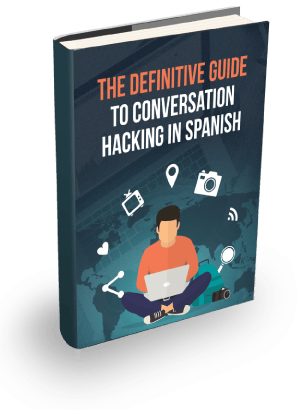Language learning mindset is critical to learning Spanish quickly and effectively. When I was starting out with learning Spanish, I remember being completely overwhelmed by fast native speakers, discouraged by a huge list of words and verb conjugations to memorise, and disappointed by unrealistic expectations of how quickly I could achieve my goals.
So when Sean Hopwood of Day Translations, Inc. reached out to me to write a guest post about his personal struggles with learning Spanish, I was thrilled to have the opportunity to share his story with you. Take it away Sean!
My love affair with Spanish began at the naïve, tender age of eight. My small town of Bartow, Florida, had this funky flea market and I remember buying some Mexican comedy tapes there one day.
When I went home, excited, I remember putting on the tapes and spending the whole night trying to decipher the jokes. I so was frustrated because I couldn’t understand why the people were laughing in the background. What was so funny? I wanted to know what everyone was laughing at. That was the moment I decided I’d really start learning Spanish.
Later my early flirtation with Spanish turned into something more serious. I eventually mastered fluency in Spanish, majored in the language in college, and started a translations company that offers quality Spanish translation services.
Looking back, my journey in learning Spanish had a lot more ups than downs. But I understand that other Americans don’t have it so easy. I’ve noticed that a big reason why they choose Spanish as a second language is because they’ve heard it’s a relatively easy language to learn. When the language proves to be more difficult than they imagined, problems ensue.
And yet, I sympathize deeply with anyone who goes up against the many obstacles and difficulties Spanish offers the non-Spanish speaker because I myself have been through them all.
The humbling nature of being a beginner overwhelmed by Spanish grammar, or the speed and colloquial language used by a native Spanish speaker, is still fresh in my memory.
The key to overcoming all obstacles in Spanish is understanding that the sense of humility you feel in trying to understand or speak Spanish can help keep you grounded and motivated even when you’re experiencing a personal low in your journey to learning the language. Your humility invites others to help you and their support, in turn, sustains you to stay motivated even when you’re feeling down.
What follows are a few of the main language obstacles I’ve encountered after several years of studying Spanish and my take on how you may best approach them.
How to approach the subjunctive mood
The subjunctive mood has thwarted many a beginner trying to master its usage. I have friends who consider it an unlearnable nightmare – a nemesis in a battle that often seems pointless. Not only do you have to worry about developing a sense of the correct context in which to use it, but you also have to worry about hitting on the right verb conjugation. This is a double whammy of mistakes waiting to happen.
Here’s my advice: when you think about the Spanish subjunctive mood, try to remember that the future is open to chance and hypothetical in nature. This can help you substantially anticipate the correct context for using this conjectural mood.
For example, the word cuando, which means “when”, signals that you’re either going to talk about a hypothetical situation that hasn’t happened yet (when I go) or something that takes place on a regular basis (when I go – I always go). Learning to differentiate and separate the two contexts ultimately paves the way for you to understand which one carries the subjunctive mood of the verb.
The same notion applies to phrases that express emotion. The word quiero (I want) conveys that just because you want something doesn’t mean you will necessarily receive it. This is why the term “I want you to know” is quiero que sepas, which is in the subjunctive tense.
Another twist to the difficulty of learning the subjunctive is having to remember the subjunctive conjugation of irregular verbs. The word caber (to fit) for example, conjugates to quepa in the present subjunctive mood, such as in ojalá que quepa (I wish that it would fit). Caber and quepa are two radically distinct words that can trip up anyone trying to apply the subjunctive.
To get a grip on the subjunctive, I recommend plowing through grammar book exercises while using flashcards for the verb conjugations. The constant exposure and drilling to examples greatly helped me get on top of the subjunctive and better understand why, when and how to use it.
How to adapt to accents and dialects
Another big obstacle to learning Spanish is contending with the diverse array of Spanish accents and dialects. Having studied and lived in Spain and Colombia while learning the language, I’ve become more or less used to the cadence and rhythms that Spanish speakers communicate.
That said, there are a few particular regional accents and dialects out there that have really troubled me.
Andalusian Spanish is one such dialect that has been problematic due to the way they use colloquial language, diminutives and make a lot of cultural references. For example, in Andalusia, they have a strange penchant for a man named Manolo. They throw his name in their colloquialisms frequently, i.e.tengo más hambre que los pollos de Manolo (literal translation: I’m hungrier than Manolo’s chickens, figurative translation: I’m extremely hungry).
In my experience, I’ve found it easier to understand Colombian and Mexican speakers since they tend to speak slower. However, dialectically, these regions employ or adopt certain words that wouldn’t be standard in Spain. And the dialect taught in American high schools everywhere. For instance, Colombians will use the formal pronoun in Spain (usted) despite being in a relationship or situation of intimacy or familiarity. In Argentina, the pronoun vos (in English: you) is used regularly instead of tú (like they do in other parts of the Spanish-speaking world).
Vocabulary is often unique to a region as well. In Argentina, for example, they say pelo enrulado to indicate ‘curly hair’ and not pelo crespo, as they would in Colombia. With many examples for indigenous vocabulary abound, it only makes sense to learn the vocabulary of the Spanish-speaking region that interests you.
In my case, I wanted to know everything. So I exposed myself to media from a wide range of countries in the form of books, films and TV shows. I also Googled the heck out of anything I wasn’t sure about or ever came across before. I recommend you do the same.
How to handle fast Spanish speakers
For me, fast native Spanish speakers are still a challenge. Firstly, high speed Spanish makes comprehension difficult, if not impossible. And secondly, it damages your own set of expectations on how soon you will be able to speak the language.
To manage fast native speakers, I recommend turning to Colombian or Mexican resources first. These accents tend to be clearer and slower than what I’ve experienced from Iberian Spanish speakers.
On the other hand, you can adapt to the quick pace of faster native speakers over time by exposing yourself to the language as much as possible.
To really develop your ear for the language, I recommend reading alongside audiobooks, listening to YouTube videos and podcasts at a slower speed (you can change this in the settings) and participating in a lot of active listening exercises.
How to develop an effective language learning mindset
With regards to successfully managing your own expectations, it’s all about establishing the right mindset. Try to develop positive habits and self-talk. See if you can set your expectations low to begin with. This is so any lack of progress doesn’t easily dissuade you.
It takes a lot of work to learn Spanish. Make no mistake about it. You’re going to have to work hard, concentrate, and continue to actively expand your vocabulary. You need to progressively take small steps to raise your skills in the areas of listening, speaking, reading and writing. The speed at which you pick up the language depends entirely the amount of quality hours you put into learning.
A key to achieving quality learning is to set a specific goal in mind each time you step up to practice. For example, you could learn a certain amount of new words every day. You could take dictation on something you are listening to. Or, you could engage in conversation on a more technical subject for a little while longer than you would usually.
Remember to be consistent with learning and adapting to the language whenever you get stuck. Attack your mistakes enough and you will see results. Consistency is your master key to success.
Conclusion
Learning Spanish can be a long, arduous journey and undoubtedly, it will be full of ups and downs. Difficulties and hardship. Victories and defeats. Just as it has been for me.
Stay humble and motivated. Do the work. Make friends. Without them, the journey is too much work and no play. And play is important!
When I was in high school, I started to listen to Cumbia and Salsa music. This music fascinated me. I have always been a lover of dancing. When I arrived at college in Tampa, Florida, my fascination with Salsa continued to grow. And, I became more and more immersed in the Salsa community. While dancing to Salsa by artists like Cheo Feliciano or Hector Lavoe, I would translate the lyrics in my head. This helped me to improve my Spanish as well as associate with a lot of Spanish speakers. Spanish speakers who would enable me to practice my Spanish on a daily basis. Some of these people became my friends and they made my journey to learning Spanish a lot more enjoyable.
It’s important to take command of the journey so that it takes you to where you want it to. A solid level of fluency where you are able to fully enjoy conversation. Or, in my case, you can finally laugh and smile at comedy skits in Spanish. Or, twirl away at Salsa while appreciating the rich, full beauty of this language. Learning Spanish will take you places to which you never thought you’d go. For me, one of these places turned out to be my town’s premiere Salsa ballroom. It’s a place I frequent and, today, I couldn’t be any happier.
 Sean Patrick Hopwood is a language polyglot and a language enthusiast. His goal in life is to bring world peace through education, tolerance, and cultural awareness. He is also the President and Founder at Day Translations, Inc., a global translation company that offers Spanish translation services.
Sean Patrick Hopwood is a language polyglot and a language enthusiast. His goal in life is to bring world peace through education, tolerance, and cultural awareness. He is also the President and Founder at Day Translations, Inc., a global translation company that offers Spanish translation services.




es muy útil, voy a aprender más y entretenerme a la vez. (hablo indonesio)
¡Me alegro!